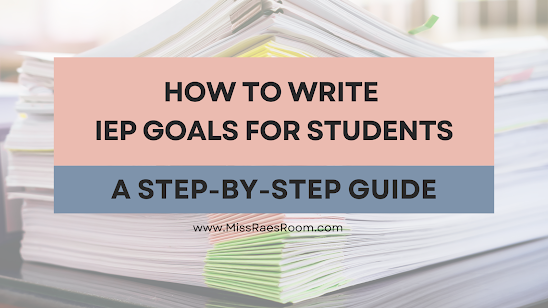How to Write SMART IEP Goals
How to Write SMART IEP Goals:
A Quick & Easy 8-Step Formula for Special Educators
Let’s be honest—Special Education teachers love working with students. Helping them learn, grow, and reach their goals is the most rewarding part of the job. But the paperwork? Not so much.
If you've ever volunteered to cover recess duty, sharpen pencils, or—let’s be real—even taken a bathroom break just to avoid writing IEP goals, you're not alone. Writing IEPs can feel overwhelming and tedious, even for seasoned educators.
But here’s the truth: it doesn’t have to be that way.
With the right tools and structure, IEP goal writing becomes straightforward—and dare I say—manageable! That’s why I created my go-to strategy: the SMART IEP Goal Formula. It’s simple, effective, and it actually makes writing goals feel doable (yes, really).
Ready to change how you feel about IEP goals? Let’s dive into this step-by-step formula that breaks everything down.
STEP 1: Identify the Goal Areas
Start with the big picture.
Ask: What is the student’s qualifying disability?
Students qualify for Special Education under one (or more) of 13 disability categories outlined in IDEA:
-
Specific Learning Disability
-
Autism
-
Deaf-blindness
-
Deafness
-
Emotional Disturbance
-
Hearing Impairment
-
Intellectual Disability
-
Multiple Disabilities
-
Orthopedic Impairment
-
Other Health Impairment
-
Speech or Language Impairment
-
Traumatic Brain Injury
-
Visual Impairment
(Note: States can modify how these categories are applied—be sure to follow your state’s guidelines.)
You can learn more about how students qualify for Special Education HERE!
Once you've identified the disability, ask: How is it impacting the student’s access to the general curriculum? That impact will point you toward your goal areas.
Example:
A student with a Specific Learning Disability in reading struggles with decoding and phonemic awareness, scoring about two years below grade level. However, she has strong listening and reading comprehension at her independent reading level. In this case, she doesn’t need separate goals in Science or Social Studies—instead, accommodations like audiobooks can remove the reading barrier in content areas.
This student's IEP goals should focus on phonemic awareness and phonics.
STEP 2: S = Specific
What, exactly, does the student need to be able to do?
Use present level data to identify the lagging skill. Let’s go back to our example student, Zoe, and just look at the phonics goal area:
Zoe’s data:
-
DIBELS Nonsense Word Fluency (NWF): Score of 23 (strategic support range)
-
Fry Sight Words: 95% accuracy
-
Quick Phonics Screener: Late 1st/early 2nd grade level; struggles with v-e syllables, final stable syllables (e.g. /tion/, /ture/), and long vowel teams (/ea/, /ai/)
SMART Goal - Specific Component:
Zoe will be able to read mulit-syllabic words containing v-e syllables, final stable syllables (e.g. /tion/, /ture/), and long vowel teams (/ea/, /ai/).
STEP 3: M = Measurable
How will you measure progress?
You need a reliable, curriculum-based assessment tool. In Zoe’s case, we’ll stick with DIBELS since we already have baseline data.
SMART Goal - Measurable Component:
Zoe will achieve a score of 40 (or greater) on the DIBELS NWF subtest.
STEP 4: A = Achievable
Is the goal realistic and appropriate for the student?
Review:
-
Zoe’s cognitive profile (check with your school psychologist if needed)
-
Current performance
-
Consistent skill deficits (from multiple assessments)
-
Scope & sequence of phonics instruction (e.g. FUNdations)
Also consider:
Type of instruction (e.g. given direct instruction using research-based, multi-sensory, specialized instruction)
-
Instructional setting (e.g. small group)
-
Supports/accommodations (e.g. direct instruction, graphic organizers, cues)
SMART Goal - Achievable Component:
Given direct instruction in a small group, Zoe will achieve a score of 40 (or greater)...
STEP 5: R = Results-Oriented
How will you know the student has truly mastered the skill?
We’re looking for consistency here—not just one good test day.
Tip: Use 3+ consecutive data points showing mastery.
SMART Goal - Results-Oriented Component:
...on at least 3 consecutive administrations of the DIBELS NWF subtest.
STEP 6: T = Time-Bound
When will the goal be achieved?
Most IEP goals are written for a 12-month period.
SMART Goal - Time-Bound Component:
By the end of the IEP period...
STEP 7: Put It All Together
Here’s how Zoe’s SMART IEP Goal looks with all five elements combined:
By the end of the IEP period, given direct specially designed instruction in a small group, Zoe will read mulit-syllabic words containing v-e syllables, final stable syllables (e.g. /tion/, /ture/), and long vowel teams (/ea/, /ai/), evidenced by achieving a score of 40 (or greater) on the DIBELS subtest NWF, on at least 3 consecutive administrations.
Want some alternatives for sentence structure? Try one of these:
Frame 1:
[Student] will [Specific skill] by achieving [Measurable accuracy] on [Assessment], given [Supports], on [Results-based evidence] by [Timeframe].
Frame 2:
By [Timeframe], [Student] will [Specific skill] in [Setting], as measured by [Tool], [Results requirement], and given [Supports].
Frame 3:
By [Timeframe], given [Supports], [Student] will [Specific skill] as measured by [Tool] and [Results requirement].
STEP 8: Write the Benchmark Objectives
Now that you have your goal, it’s time to break it into smaller, teachable objectives. These are the stepping stones that build toward mastery.
Remember that list of subskills you made in Step 4? That’s your goldmine!
Use it to outline the key benchmarks Zoe needs to hit along the way.
Get ALL of the IEP resources you need HERE!
Want a printable SMART goal cheat sheet? Click HERE!


.png)



Comments
Post a Comment